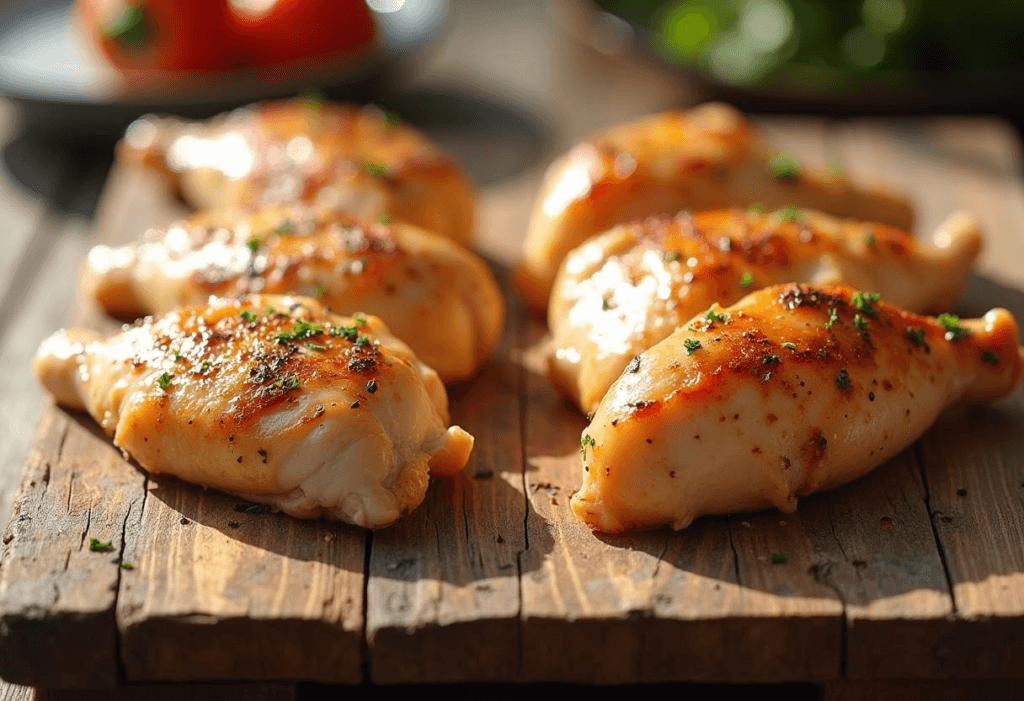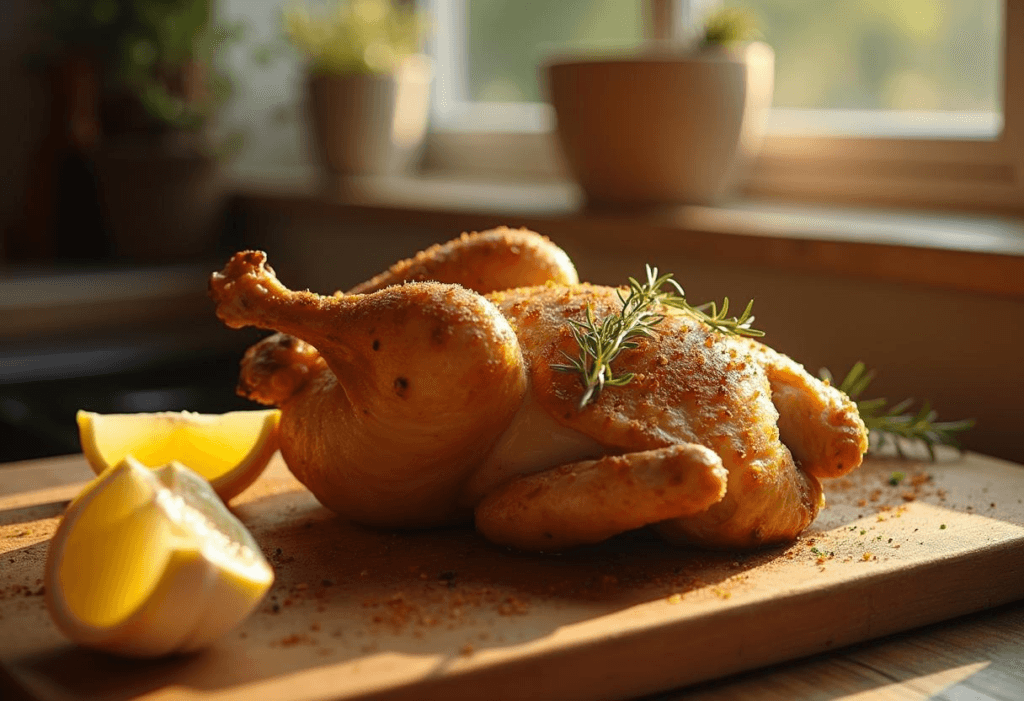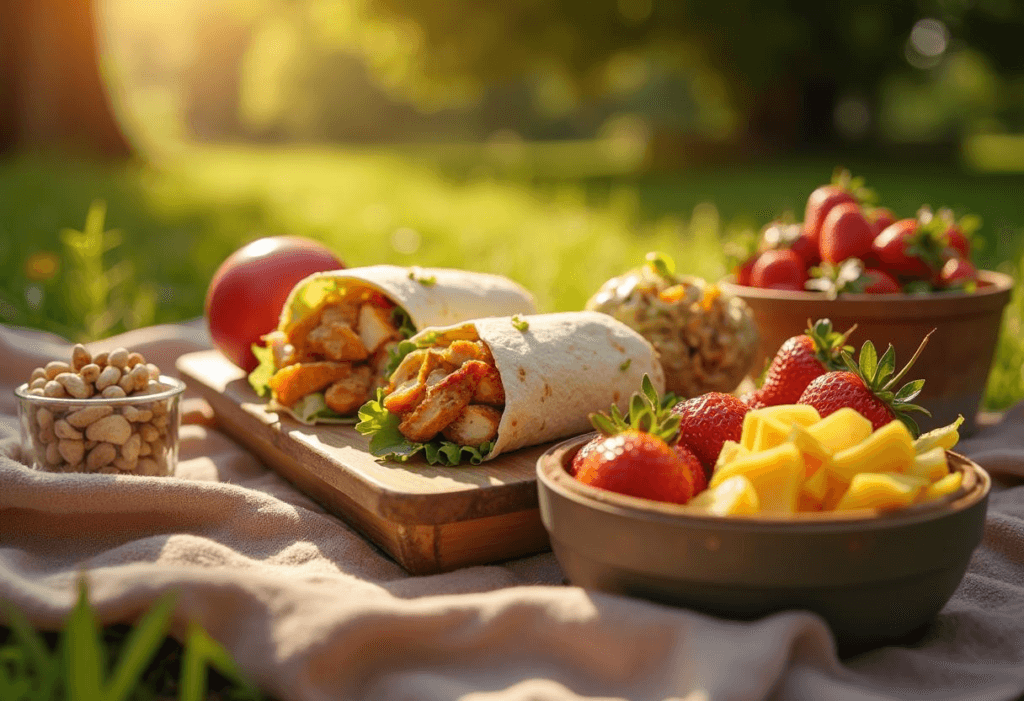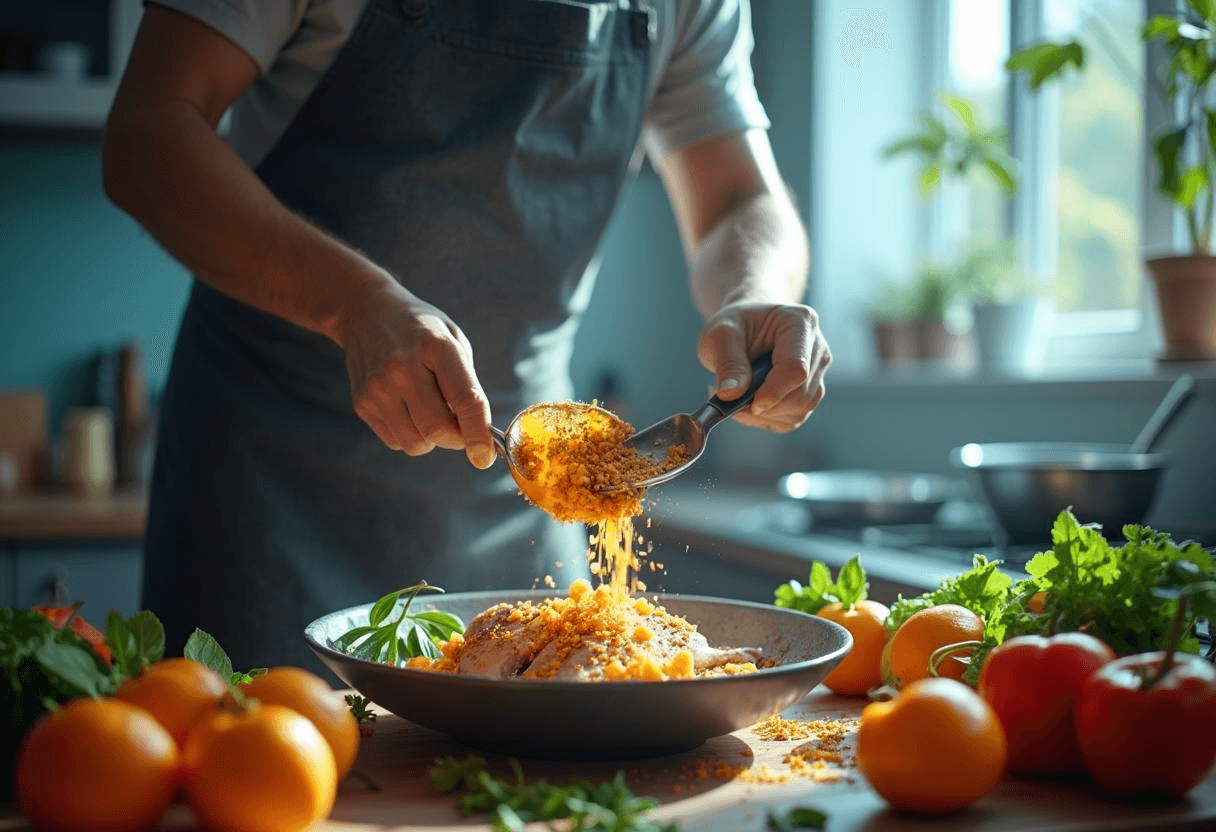Why Cooking Methods Matter for Protein Retention
« How do I cook chicken with the most protein? » This question is essential for anyone serious about nutrition. Cooking chicken the right way is critical if you want to retain the most protein and get the maximum nutritional benefits.
Whether you’re an athlete, on a high-protein diet, or just trying to eat healthier, knowing how to cook chicken with the most protein can make a huge difference in your meals. The wrong cooking methods can destroy essential nutrients, while the right ones help preserve every gram of protein. In this guide, we’ll break down the best ways to cook chicken for maximum protein retention, the top cuts to choose, and how to avoid common cooking mistakes. Let’s get started!
« The way you cook chicken affects not only its protein content but also its texture, flavor, and digestibility. Choosing the right method ensures you get the most out of every bite. » – Dr. James Foster, Nutrition Expert
Now that you understand why cooking methods matter, let’s explore High-Protein Chicken Recipes: Delicious and Nutritious Meals for Every Occasion to put this knowledge into action
Best Chicken Cuts for Maximum Protein Content
Not all parts of the chicken are created equal. Some cuts are leaner and packed with protein, while others contain more fat. Here’s what you need to know when choosing the best cut for your high-protein meals.

If you’re aiming for pure protein, skinless chicken breast is the best option. However, if you prefer more flavor and juiciness, chicken thighs are a great alternative.
Now that you know which cuts offer the most protein, let’s dive into the science behind protein loss during cooking.
Chicken Breast vs. Thighs: Which Has More Protein?
Chicken breast is often the go-to for people focusing on high protein and low fat. But does it really have more protein than thighs? Let’s compare:
| Chicken Cut | Protein (per 100g) | Calories | Fat |
|---|---|---|---|
| Chicken Breast | 31g | 165 kcal | 3.6g |
| Chicken Thigh | 24g | 209 kcal | 11g |
| Chicken Drumstick | 27g | 172 kcal | 5.7g |
| Chicken Wings | 20g | 203 kcal | 13g |
As you can see, chicken breast wins in terms of protein-to-fat ratio. If you’re looking for pure muscle-building protein, go for skinless chicken breast. However, if you want a juicier and more flavorful option, thighs are a great alternative.
Skinless vs. Skin-On Chicken: Does It Affect Protein?
The short answer? No, the skin doesn’t affect protein content—but it does add extra fat and calories. If you’re watching your calorie intake, opt for skinless chicken.
The Science of Protein Loss: How Do I Cook Chicken with the Most Protein?
Did you know that excessive heat can break down protein molecules? Cooking chicken at very high temperatures for long periods can denature proteins, making them less bioavailable to your body.
How Heat Affects Chicken Protein Structure
Protein consists of long chains of amino acids that get broken down when exposed to high temperatures. While some cooking is necessary, you don’t want to overdo it.
« Cooking at moderate heat helps retain more protein while preventing the formation of harmful compounds found in overcooked meats. » – Dr. Emily Carter, Food Scientist
How Do I Cook Chicken with the Most Protein? Avoid These Common Mistakes
Here are some common mistakes that can destroy the protein quality in your chicken:
Overcooking at High Temperatures – Leads to tough, dry chicken and protein loss.
Boiling for Too Long – Water-soluble nutrients leach out into the cooking liquid.
Deep Frying – Adds unnecessary fats while breaking down delicate protein molecules.
Using Processed Marinades – Some marinades contain acids that degrade proteins over time.
Now, let’s move on to how to cook chicken the right way!
How Do I Cook Chicken with the Most Protein? Best Methods Explained
If you want to maximize protein retention, the key is to use gentle cooking methods that don’t destroy amino acids. Let’s break down the best and worst cooking techniques.

Grilling vs. Baking vs. Boiling: Which is Best?
| Cooking Method | Protein Retention | Pros | Cons |
|---|---|---|---|
| Grilling | High | Enhances flavor, quick cooking | Risk of overcooking |
| Baking | Very High | Even cooking, retains moisture | Takes longer |
| Boiling | Moderate | Easy, soft texture | Protein loss in water |
| Frying | Low | Crispy texture | High in unhealthy fats |
Best Choice: Grilling or Baking at moderate heat (350-400°F) keeps protein intact while maintaining moisture.
How Do I Cook Chicken with the Most Protein? Slow Cooking vs. Pressure Cooking
Both methods are great, but they have different effects on protein retention.
✅ Slow Cooking: Low temperatures preserve proteins, but long cooking times may break some down.
✅ Pressure Cooking: Short cooking time retains more protein, but excessive heat can still cause loss.
Pro Tip: If boiling or pressure cooking, save the broth! It contains dissolved proteins and nutrients.
How Do I Cook Chicken with the Most Protein and Essential Nutrients?
Cooking chicken isn’t just about protein—you also want to retain vitamins and minerals. Here’s how to make nutritious, high-protein chicken meals.
Using Marinades to Retain Protein and Moisture
A good marinade enhances flavor and prevents protein loss. The best options?
- Greek Yogurt & Lemon 🍋 – Tenderizes chicken while maintaining protein.
- Olive Oil & Herbs 🌿 – Keeps moisture locked in.
- Soy Sauce & Ginger 🍛 – Adds depth without breaking down proteins.
Avoid marinades with too much vinegar or citrus, as they can degrade proteins over time.
Best Seasonings and Herbs for High-Protein Chicken
- Garlic & Paprika – Boosts flavor without overpowering protein.
- Rosemary & Thyme – Enhances natural taste.
- Cumin & Black Pepper – Adds heat while supporting digestion.
How Do I Cook Chicken with the Most Protein? Try These Recipes
Time to get cooking! Here are some delicious, protein-packed recipes you can make at home.
Breakfast: High-Protein Chicken Omelet 🥚
| Ingredient | Quantity |
|---|---|
| Egg whites | 3 |
| Cooked chicken (diced) | ½ cup |
| Spinach | ½ cup |
| Olive oil | 1 tsp |
Instructions:
1- Heat oil in a pan and sauté spinach.
2- Add diced chicken and cook for 2 minutes.
3- Pour in egg whites and cook until set.
4- Serve with a sprinkle of black pepper.
🛑 Nutrition Per Serving: 250 kcal | 40g protein | 5g fat | 3g carbs
We’ve covered why cooking methods matter, which cuts are best, and how to cook chicken without losing protein. In Part 2, we’ll go deeper into meal prepping, storing high-protein chicken correctly, and fixing common cooking mistakes.
How Do I Cook Chicken with the Most Protein?
Meal Prep, Storage, and Common Mistakes
Welcome back! Now that we’ve covered the best chicken cuts and cooking methods to preserve protein, it’s time to dive into meal prepping, storage tips, and fixing common cooking mistakes. These steps will help you maintain high protein content in your chicken dishes while keeping them fresh and flavorful. Let’s get started!
How Do I Cook Chicken with the Most Protein for Meal Prep?
Meal prepping is a game-changer when it comes to maintaining a protein-rich diet. Having pre-cooked chicken meals ready means you’re less likely to grab unhealthy snacks or fast food. But how do you prep chicken without losing its nutrients and taste? Here’s what you need to know.

How to Store Cooked Chicken for Maximum Freshness
The way you store your chicken determines how fresh and nutritious it remains throughout the week.
Refrigerate Properly: Store cooked chicken in an airtight container and keep it in the coldest part of your fridge.
Use Glass Containers: Plastic absorbs odors; glass keeps food fresh longer.
Keep It Dry: Too much moisture in storage leads to bacterial growth.
« Cooked chicken stays fresh in the fridge for up to 4 days. If you need to store it longer, freezing is your best option. » – Chef Mark Davies
Freezing Chicken Without Losing Protein
If you’re cooking chicken in bulk, freezing is a great way to preserve its protein and taste. Follow these steps:
1️⃣ Let the chicken cool completely before freezing.
2️⃣ Wrap it in parchment paper to prevent freezer burn.
3️⃣ Store in ziplock bags or airtight containers.
4️⃣ Label with the date to keep track of freshness.
🔹 Frozen chicken lasts up to 3 months while still maintaining high protein quality!
How Do I Cook Chicken with the Most Protein When Reheating?
Reheating chicken the wrong way can turn it dry and tasteless while also degrading proteins. Here’s how to do it right:
| Method | Effect on Protein | Best Practices |
|---|---|---|
| Microwave | Slight protein loss | Cover with a damp towel to keep moisture |
| Oven | Minimal protein loss | Reheat at 300°F for 10 minutes |
| Stovetop | Best for texture | Add a little broth to keep it juicy |
Common Problems When Cooking High-Protein Chicken
Even if you use the right cooking techniques, mistakes can happen. Here are the most common chicken-cooking mistakes and how to fix them.
Dry and Overcooked Chicken: How to Fix It
Problem: Overcooked chicken becomes tough and rubbery, making it less enjoyable to eat.
Solution: Use a meat thermometer and cook until the internal temperature reaches 165°F (74°C). Anything beyond that dries out the meat.
Pro Tip: If your chicken is already dry, slice it thin and soak it in broth or sauce before serving to add back moisture.
Lack of Flavor: Enhancing Taste Without Losing Protein
Problem: Many people think eating high-protein meals means eating bland food.
Solution: Use natural seasonings, fresh herbs, and healthy marinades instead of relying on processed sauces with hidden sugars.
Try These High-Protein Chicken Marinades:
| Marinade | Ingredients | Best For |
|---|---|---|
| Greek Yogurt & Lemon | Yogurt, lemon juice, garlic, olive oil | Grilled chicken |
| Soy Sauce & Ginger | Soy sauce, ginger, garlic, sesame oil | Stir-fried chicken |
| Herb & Olive Oil | Rosemary, thyme, olive oil, black pepper | Baked chicken |
« Marinating chicken for at least 30 minutes helps retain moisture and enhances flavor while preserving protein. » – Chef Amelia Rodriguez
High-Protein Chicken Meal Plan for a Full Week
Now that we’ve mastered cooking and storing high-protein chicken, let’s plan an entire week’s worth of meals. These dishes are easy to make, packed with protein, and taste amazing!
7-Day High-Protein Chicken Meal Plan
| Day | Lunch | Dinner |
|---|---|---|
| Monday | Grilled Lemon Chicken Salad | Spicy Cajun Chicken Stir-Fry |
| Tuesday | Chicken Avocado Wrap | Garlic Butter Chicken with Spinach |
| Wednesday | Chicken Quinoa Bowl | Buffalo Chicken Lettuce Wraps |
| Thursday | Mediterranean Chicken Skewers | Spiced Turmeric Chicken |
| Friday | Balsamic Glazed Chicken | Slow Cooker Chicken Chili |
| Saturday | High-Protein Chicken Omelet | Thai Basil Chicken |
| Sunday | BBQ Chicken with Sweet Potatoes | Oven-Baked Parmesan Chicken |
Pro Tip: Prep two types of chicken at the start of the week and use them in different meals to save time.
Frequently Asked Questions About Cooking Chicken for Protein
Can I eat chicken every day for protein?
Yes! Chicken is a complete protein source that supports muscle growth, weight loss, and overall health. Just make sure to rotate your cooking methods for variety.
What’s the healthiest way to cook chicken?
Grilling and baking at moderate temperatures preserve the most protein while avoiding excess fats.
How can I make chicken more tender while keeping its protein?
Marinate it in yogurt, lemon juice, or olive oil before cooking. This helps break down muscle fibers, making it softer and juicier.
Does freezing chicken affect its protein content?
No! Freezing preserves protein levels, but make sure to store it properly to avoid freezer burn.
What is the best time to eat high-protein chicken meals?
For muscle recovery, eat a protein-packed meal within 30-60 minutes after a workout.
Conclusion: Mastering the Art of High-Protein Chicken Cooking
So, how do I cook chicken with the most protein? It isn’t just about throwing it on the grill. It’s about choosing the right cuts, using the best cooking methods, and storing it properly.
By following these tips, you can:
Get the most protein out of every meal
Keep your chicken juicy, flavorful, and nutritious
Make meal prepping easier and healthier
Now, it’s time to put this knowledge to work! Try out a new high-protein chicken recipe this week and enjoy the health benefits!

